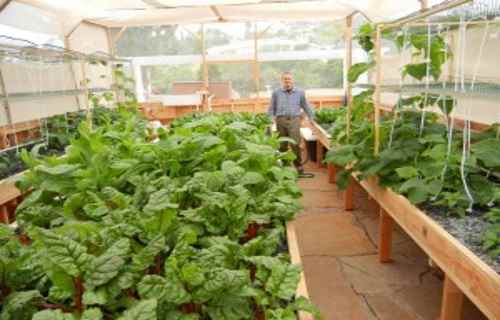Become a Millionaire on One Acre with Aquaponics
Build a large Aquaponics system for $25.00, farm Crayfish and Vegetables.
With an ROI (Return on Investment) of three to five years, and the possibility that by addressing a specific local market needed to produce a specialty crop such as kale, basil or bok choy, and reducing the ROI to less than two years, investors start to take notice. When a single commercial installation pencils out to yield a net-net in the low six figures and the output can match any wholesale supplier’s prices and still make money, serious investors take note.
Commercial aquaponics installations are not subject to the normal vulgarities of the stock market, derivatives markets, political upheaval, drought, electrical outages, heat waves, unusually hot or cold weather or even state-sponsored corruption.
Aquaponics is trending and today, even city planners are focusing on funding for both hydroponics and aquaponics systems to create higher degrees of food security in large cities to feed their growing urban populations. Their plans include the use of vacant lots for the installation of attractive greenhouses and retrofitting empty warehouses for growing food year round with the addition of grow lights.
The most common request we receive from those would like to become commercial aquaponics farmers is from people who already have the land and want to begin to cover it in aquaponics installations, BUT they do not have the money to make the initial large investment.
One acre of flat, level land covered with Aquaponics Systems can make you a millionaire and with an ongoing income of over $300,000 from the full acre per year NET. To fund this size operation all at one time requires approximately US$1.2Million.
RELATED : The Best 5 Gardening System to Grow Food for all Your Family Every Year Even in a Desert
Here are several scenarios that demonstrate how to achieve this level of success is stages over time.
Your personal situation will obviously differ from these specific instances, but you can use these scenarios as examples and then adjust them for your unique situation.

Assumptions:
Land cost is not a factor – meaning the land is owned or leased at a low rate already
You have access to $200,000 of capital or the ability to borrow that much
Hard work is not a problem
Marketing is a passion and a way of life for you
You or your partners have successfully operated a growing business for more than 5 years
You are willing to invest the time to prepare a quality business plan before you begin.
 Five Suggested Scenarios and Options for Beginning your Aquaponics Business
Five Suggested Scenarios and Options for Beginning your Aquaponics Business
First Scenario: You already own the land and it has access to electricity and water and it is mostly flat and level. While solar power and well water are options, they come with additional costs. This land is located near your potential markets for selling your food, and you do not have the investment capital to begin the project. Currently, your land is not paying you anything in return but you are paying taxes on it, and there are other normal expenses that you incur by owning it.
(Brace yourself, this suggestion may hurt . . . )
Sell enough of your land to fund the first acre or even the first 10,000 sq. ft. aquaponics installation. That way, it is your money you are investing in your own aquaponics business and you are paying yourself back with interest. For example, the ‘average’ size of currently owned acreage of those we have talked with, is 10 to 12 acres (the range is from 2 acres to several thousand acres). If a portion of this land was sold, even most of it, the project could be at least partially funded from the proceeds.

Second Scenario:
Refinance the land and use the proceeds to build the first aquaponics installation(s). This may or may not please your banker, but he will enjoy being paid back in a few years.
Third Scenario:
Find some partners to fund the installation of the aquaponics installation on your land. Be the ‘land guy’ and be willing to structure the deal so you are the last to be paid off. After all, it is your land and the installation is on your property and it will be producing income far into the future. You may even want to structure the deal to pay off your partners in total, first, and then you will continue to receive all the income for yourself.
 Fourth Scenario:
Fourth Scenario:
You don’t own the land but you know someone who does own it, and you are willing to do all the work to make this project happen. Ask them for permission for you to use one acre of their land for aquaponics installations for a piece of the action. In layman’s terms this means they receive some of the profits. Approach several other investors to fund the installations and then you would provide the hard work of operating the commercial aquaponics system. This is the hardest scenario to accomplish UNLESS you have a proven track record running businesses.
Fifth Scenario:
Find a number of existing greenhouses in your area that you can lease and then install the Portable Farms Aquaponics Systems Modules to fit the greenhouse(s). Then use this installation to generate the capital needed to finance the expansion of additional units on your unused property. The upfront cost of doing this is a fraction of the cost of building from scratch.
A single 10,000 sq. ft. greenhouse structure, just the building,
Technology, has an initial capital cost of US$130,000 to US$230,000 (depending on the cost of the greenhouse you choose) but does not include the land/property costs
A single 10,000 sq. ft. facility can hold approximately 30 Portable Farms® Aquaponics Systems Modules costing from $80,000 to $100,000, installed
The ROI can be from 2 to 4 years depending on your markets and the crops you choose to grow and sell
Payroll for two full time employees to operate a single commercial PFAS Unit (30 modules)
The Net-Net for this example is US$100,000 per year
Four PFAS Units (120 modules) are needed to be a millionaire
Four PFAS Units will require approximately US$1,000,000 of initial investment.
RELATED : Build a $300 underground greenhouse for year-round gardening
 To start, do your homework, complete your marketing survey, talk to the casino, high-end restaurant and resort hotel chefs to see how much of their weekly produce they are willing to buy from you. Talk to at least TEN chefs, add the numbers of different vegetables they are requesting together, divide by two (this gives you the built-in expansion for your business) and design your installation to fulfill that amount of produce by the end of your first year of production.
To start, do your homework, complete your marketing survey, talk to the casino, high-end restaurant and resort hotel chefs to see how much of their weekly produce they are willing to buy from you. Talk to at least TEN chefs, add the numbers of different vegetables they are requesting together, divide by two (this gives you the built-in expansion for your business) and design your installation to fulfill that amount of produce by the end of your first year of production.
Yep, it’s a LOT of hard work, focus, yours and/or other people’s money and a dedication to bringing the finest food on the planet to your market that can make you a millionaire is a few short years. You actually have to do the work to get there. PFAS LLC’s Portable Farms® Aquaponics Systems technology is one way to have fun in the process.
Commercial aquaponics programs will change the face of aquaponics, make their investors very happy, create jobs for thousands of people and equally important, provide the highest quality, locally grown food for the growing middle class around the world. The technology of aquaponics, especially as a viable alternative to long-food-miles groceries is finally becoming a part of mainstream thinking. As the acceptance of aquaponics moves from fringe idea to proven commercial production, there has been a profound shift in those who are interested in applying the technology and how they are affecting the industry. Now the moneyed people (read serious investors), the visionaries with immense deep pocket connections and the people who can make a difference in the world are stepping into the arena to be serious players.
Easy and cheap DIY the best system to grow your organic and living food bank
Aquaponics is at least 4,700 years old and has been practiced in various forms in many places in the world, especially where population pressures were high and the land was limited in some fashion. Maximizing the nutrient stream is critically important when land is restricted. The use of animal’s waste to encourage the growth of aquatic plants and animals is an elegant solution to a waste water management problem. Modern aquaponics offers a locally based, extremely high yield, food production facility that also provides permanent full time jobs for semi-skilled workers. When a concentration of modern aquaponics installations occurs, an increasingly sophisticated and broader administrative function is required to run them effectively. Another benefit of these installations is the creation of many secondary jobs. These additional jobs normally add four to seven additional local positions in the support function businesses.
By : Colle Davis, Phil Estes and Phyllis Davis
This is how to make your own Aquaponics system for fish and plant production at home. I built the unit from easy to find materials and cost only $25.00 to build. I use Crayfish instead of fish for my tanks as the produce more fertilizer than fish.
The Lost Ways (Learn the long forgotten secrets that helped our forefathers survive famines,wars,economic crisis and anything else life threw at them)
Survive Attack to Our Power Grid System (Weapon That Can Instantly End Modern Life in America)
Survival MD (Best Post Collapse First Aid Survival Guide Ever)
Backyard Innovator (A Self Sustaining Source Of Fresh Meat,Vegetables And Clean Drinking Water)
Blackout USA (EMP survival and preparedness)
Conquering the coming collapse (Financial advice and preparedness )
Liberty Generator (Build and make your own energy source)
Backyard Liberty (Easy and cheap DIY Aquaponic system to grow your organic and living food bank)
Bullet Proof Home (A Prepper’s Guide in Safeguarding a Home )
Family Self Defense (Best Self Defense Strategies For You And Your Family)
Survive Any Crisis (Best Items To Hoard For A Long Term Crisis)
Survive The End Days (Biggest Cover Up Of Our President)
Drought USA (Discover The Amazing Device That Turns Air Into Water)





I want more and more of this!!